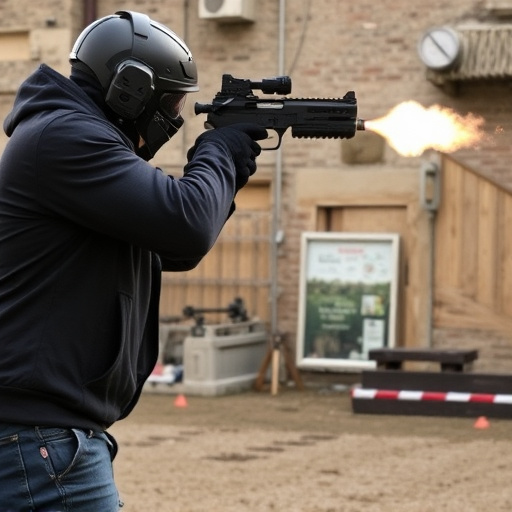Taser deployment uses small probes to deliver powerful electric shocks, temporarily paralyzing targets. Compact, discreet most concealable stun gun designs offer enhanced portability for self-defense. Despite their size, these devices require proper training due to potential physical and psychological impacts, including muscle control disruption, falls, fear, and anxiety. Understanding these effects is crucial for designing regulations prioritizing safety with increasingly accessible and discreet stun guns.
“Taser deployment, a tactic employed by law enforcement worldwide, can lead to temporary paralysis. But how long does this effect last? This article delves into the factors influencing paralysis duration after taser use, offering insights that are crucial for understanding both public safety and individual recovery.
We explore the physical and psychological impacts of taser deployment, dissecting the role of age, physical condition, taser type, and environmental conditions. Furthermore, we present design considerations for the most concealable stun gun, focusing on lightweight, advanced technology, and ergonomic features to enhance concealment and reduce shock time.”
- Understanding Taser Deployment and Its Effects
- – Definition of taser deployment and its purpose
- – Physical and psychological impacts on the body
Understanding Taser Deployment and Its Effects

Taser deployment is a complex process that involves the discharge of an electrical current to immobilize a subject. The effects of a Taser can vary depending on factors such as the model used, the distance between the officer and the target, and the individual’s physical condition. When discussing paralysis duration, understanding how Tasers work is crucial. These devices fire small probes connected to wires that deliver a powerful electric shock, temporarily disrupting muscular control, leading to immobilization. The impact can cause immediate muscle contractions and subsequent relaxation, resulting in a period of paralysis.
In terms of design, the most concealable stun gun concept often comes into play when considering Tasers for personal protection. Compact and discreet models allow users to carry them more easily, enhancing their potential as self-defense tools. However, it’s important to note that while these designs may make them less noticeable, they do not diminish the power or impact of the device. The effects still depend on proper deployment and contact with the target, making training and understanding the technology vital for both law enforcement officers and individuals seeking personal protection.
– Definition of taser deployment and its purpose

Taser deployment refers to the act of using a taser—a type of electronic control device (ECD) or stun gun—to temporarily incapacitate an individual for the purpose of self-defense, law enforcement, or security. Tasers work by delivering a strong electric current through two small probes attached to thin wires, which disrupt muscle control in the body, causing temporary paralysis. The primary goal of taser deployment is to disable a person without causing permanent harm, providing critical time for de-escalation, backup, or intervention.
When it comes to stun guns, the most concealable design plays a significant role in their practicality and legality. Advanced technologies have led to compact, discreet models that can easily fit into everyday items like pens, flashlights, or even keys, making them appealing for personal protection. These concealed stun guns are designed to be easy to carry and use, providing individuals with an extra layer of safety without drawing unnecessary attention. Their small size, combined with high voltage outputs, makes them effective tools for self-defense in various situations.
– Physical and psychological impacts on the body

The physical and psychological effects of a taser deployment can be profound, especially considering the device’s ability to cause temporary paralysis. When activated, stun guns emit an electric current that disrupts muscle control, leading to neuromuscular incapacitation. This rapid response can have immediate consequences, such as loss of balance, weakness, or even falling, which may result in secondary injuries. The duration of paralysis is a key factor; longer periods can increase the risk of complications, particularly in individuals with pre-existing health conditions.
On a psychological level, the experience of being stunned by a taser can be traumatic. The intense electric shock and subsequent sensory disorientation can induce fear and anxiety, even in those without a history of mental health issues. Additionally, the sight, sound, and sensation of a taser deployment often leave lasting impressions, potentially leading to post-traumatic stress disorder (PTSD) symptoms. Understanding these impacts is crucial, especially when considering the design of concealable stun guns, as the ease of access and discreteness may encourage their use in various situations, further emphasizing the need for awareness and regulation.
Taser deployment, while often used as a means of self-defense and law enforcement control, can have significant physical and psychological effects. The duration of paralysis resulting from taser use varies, but it’s crucial to acknowledge that even brief moments of incapacitation can lead to severe consequences. In terms of design, the most concealable stun gun isn’t necessarily the best choice; a balanced approach that prioritizes both effectiveness and minimal impact should be considered. Remember that understanding the impacts and limitations of taser deployment is essential for responsible use and ensuring public safety.
